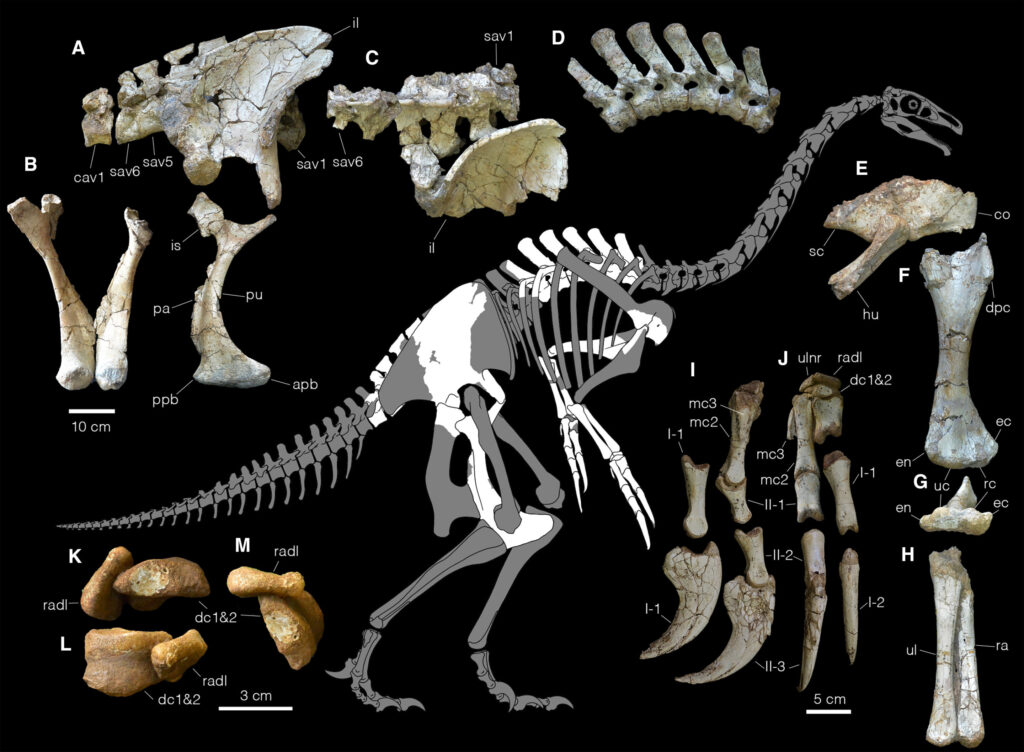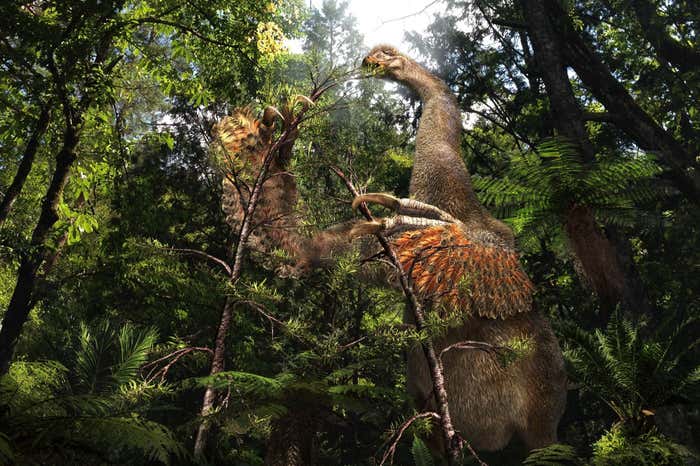A groundbreaking discovery in the field of paleontology has shed new light on the evolution of therizinosaurs, a bizarre group of plant-eating dinosaurs known for their long, curved claws. An international team of paleontologists and Earth scientists has identified fossilized remains belonging to a newly discovered species of therizinosaur that had only two claws instead of the usual three. The fossils, excavated from Mongolia’s Gobi Desert, are not only exceptionally well-preserved but also represent the largest three-dimensional dinosaur claws ever found.
The findings, published in the journal iScience, introduce Duonychus tsogtbaatari, a unique species that adds a new piece to the puzzle of dinosaur evolution. The discovery raises fascinating questions about how and why this dinosaur evolved to have two fingers, providing crucial insights into the dietary adaptations and ecological niches of therizinosaurs.
Unearthing a Prehistoric Mystery: The Fossil Discovery
In 2012, a team from the Mongolian Academy of Sciences uncovered a remarkable set of fossils in the vast, windswept expanses of the Gobi Desert—one of the richest fossil beds in the world. These fossils included nearly complete arms with claws, part of the pelvis, and much of the backbone, making it one of the most complete therizinosaur specimens ever found.
For nearly a decade, these remains sat in storage, awaiting proper analysis. It wasn’t until a recent international collaboration that researchers carefully examined the fossils, leading to the revelation that they belonged to a new and distinct species. The most striking feature? Unlike all previously known therizinosaurs, which had three fingers, Duonychus tsogtbaatari had only two.
What Was Duonychus tsogtbaatari?
Duonychus tsogtbaatari lived around 90 million years ago during the Late Cretaceous period, an era when dinosaurs were at the peak of their diversity. Based on fossil analysis, paleontologists estimate that this dinosaur measured approximately 3 meters (10 feet) in length and weighed around 270 kilograms (600 pounds).

Like other therizinosaurs, it was a bipedal herbivore, meaning it walked on two legs and fed primarily on plants. However, its most defining characteristic was its hands: instead of three claws, it had only two, each extending up to 30 centimeters (12 inches) in length. The shape and size of the claws suggest they were sheathed in keratin, the same material found in human fingernails and animal hooves. This was an astonishing find, as keratin rarely fossilizes due to its rapid decay after death.
The three-dimensional preservation of the fossil was another stroke of luck. Unlike many dinosaur fossils, which are often flattened due to millions of years of compression in rock layers, the remains of Duonychus tsogtbaatari retained their original 3D structure. This provided scientists with an incredibly detailed look at its anatomy, making it easier to reconstruct how the animal might have lived and moved.
Why Only Two Claws? Evolutionary Adaptation or Functional Advantage?
One of the biggest mysteries surrounding Duonychus tsogtbaatari is why it evolved to have only two fingers instead of the typical three seen in its therizinosaur relatives. Researchers propose that this adaptation was likely linked to its feeding behavior.
Therizinosaurs were specialized herbivores that used their claws to grasp and pull down branches, stripping leaves for food. The researchers suggest that by reducing its hand to two fingers, Duonychus tsogtbaatari may have evolved a stronger grip, allowing it to handle thicker, more fibrous vegetation. Having fewer but more robust claws would have provided a mechanical advantage, making each claw stronger than if there were three.

This adaptation is reminiscent of other theropod dinosaurs, such as the fearsome Tyrannosaurus rex, which also had two fingers. However, while T. rex lost a digit due to its reliance on powerful jaws for hunting, Duonychus tsogtbaatari likely retained strong claws to compensate for its plant-based diet.
Another possibility is that this dinosaur occupied a unique ecological niche where two claws were more beneficial than three. Since therizinosaurs coexisted with other large herbivores, such as hadrosaurs and sauropods, competition for food may have driven Duonychus tsogtbaatari to develop specialized feeding strategies.
A Window into the Prehistoric Ecosystem
The discovery of Duonychus tsogtbaatari not only expands our understanding of therizinosaur diversity but also paints a clearer picture of Mongolia’s Late Cretaceous ecosystem. The Gobi Desert, now an arid and barren landscape, was once a lush environment teeming with diverse life forms. Rivers and forests provided ample food sources for herbivorous dinosaurs, while carnivorous theropods prowled the landscape.
The presence of Duonychus tsogtbaatari in this region suggests that therizinosaurs were more varied in their physical characteristics than previously believed. Its unique hand structure hints at different feeding strategies among therizinosaurs, reflecting the adaptability and evolutionary plasticity of this fascinating group.

Implications for Dinosaur Evolution
The significance of Duonychus tsogtbaatari extends beyond its peculiar two-clawed hands. It challenges the traditional assumptions about therizinosaur evolution and raises new questions about how and why certain physical traits evolved in different dinosaur lineages.
For decades, paleontologists have debated the evolutionary relationships between therizinosaurs and other theropods. While therizinosaurs share ancestry with meat-eating dinosaurs, they evolved into slow-moving, plant-eating creatures with large bellies and long claws. The discovery of Duonychus tsogtbaatari adds another layer of complexity to this evolutionary narrative, suggesting that therizinosaurs experimented with different limb structures over time.
Additionally, this finding prompts scientists to re-examine other therizinosaur fossils that may have been misclassified due to incomplete remains. Could there be more two-clawed therizinosaurs waiting to be discovered?
Future Research and Exploration
The study of Duonychus tsogtbaatari is far from over. While researchers have analyzed the existing fossil specimens in great detail, many questions remain unanswered. For example:
- What was the exact function of its claws beyond feeding?
- Did it use them for defense, social interactions, or nesting behaviors?
- How does it fit into the broader evolutionary timeline of therizinosaurs?
To answer these questions, paleontologists plan to continue excavating in the Gobi Desert, searching for more fossils that could provide additional clues. Advances in imaging technology, such as CT scanning and 3D modeling, may also help scientists reconstruct the muscles and movements of Duonychus tsogtbaatari, offering a more complete picture of its biology.
Conclusion: A Fascinating Glimpse into the Past
The discovery of Duonychus tsogtbaatari is a testament to the wonders of paleontology and the ever-evolving story of dinosaurs. With its massive, two-fingered claws and unique adaptations, this newly named species challenges our understanding of therizinosaurs and highlights the complexity of dinosaur evolution.
As scientists continue to uncover new fossils and refine our knowledge of prehistoric life, each discovery brings us one step closer to unraveling the mysteries of the ancient world. Whether it’s in the shifting sands of Mongolia’s Gobi Desert or in laboratories around the world, the story of Duonychus tsogtbaatari is far from over.
Reference: Yoshitsugu Kobayashi et al, Didactyl therizinosaur with a preserved keratinous claw from the Late Cretaceous of Mongolia, iScience (2025). DOI: 10.1016/j.isci.2025.112141. www.cell.com/iscience/fulltext … 2589-0042(25)00401-8
